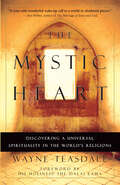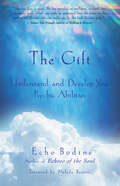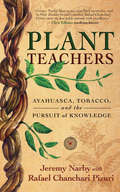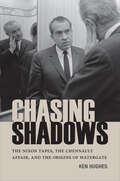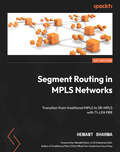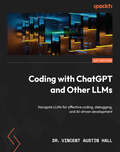- Table View
- List View
The Mystic Heart: Discovering a Universal Spirituality in the World's Religions
by Wayne TeasdaleDrawing on experience as an interreligious monk, Brother Wayne Teasdale reveals the power of spirituality and its practical elements. He combines a profound Christian faith with an intimate understanding of ancient religious traditions.
The Gift: Understand and Develop Your Psychic Abilities
by Echo BodineFor thirty-five years, best-selling author and popular workshop leader Echo Bodine has been using her psychic powers to help people gain clarity and find healing. Now she presents an accessible guide to understanding and exploring one's own psychic abilities. The book begins by dispelling common myths about psychics and defining the four psychic gifts. It then discusses the implications of becoming a professional psychic and offers self-protection techniques. Readers also learn four basic exercises for accessing the "third eye," and ways to interpret and understand psychic information.
Plant Teachers: Ayahuasca, Tobacco, and the Pursuit of Knowledge
by Jeremy NarbyA trailblazing anthropologist and an indigenous Amazonian healer explore the convergence of science and shamanism &“The dose makes the poison,&” says an old adage, reminding us that substances have the potential to heal or to harm, depending on their use. Although Western medicine treats tobacco as a harmful addictive drug, it is considered medicinal by indigenous people of the Amazon rainforest. In its unadulterated form, it holds a central place in their repertoire of traditional medicines. Along with ayahuasca, tobacco forms a part of treatments designed to heal the body, stimulate the mind, and inspire the soul with visions. In Plant Teachers, anthropologist Jeremy Narby and traditional healer Rafael Chanchari Pizuri hold a cross-cultural dialogue that explores the similarities between ayahuasca and tobacco, the role of these plants in indigenous cultures, and the hidden truths they reveal about nature. Juxtaposing and synthesizing two worldviews, Plant Teachers invites readers on a wide-ranging journey through anthropology, botany, and biochemistry, while raising tantalizing questions about the relationship between science and other ways of knowing.
Chasing Shadows: The Nixon Tapes, the Chennault Affair, and the Origins of Watergate (Miller Center Studies on the Presidency)
by Ken HughesThe break-in at Watergate and the cover-up that followed brought about the resignation of Richard Nixon, creating a political shockwave that reverberates to this day. But as Ken Hughes reveals in his powerful new book, in all the thousands of hours of declassified White House tapes, the president orders a single break-in--and it is not at the Watergate complex. Hughes’s examination of this earlier break-in, plans for which the White House ultimately scrapped, provides a shocking new perspective on a long history of illegal activity that prolonged the Vietnam War and was only partly exposed by the Watergate scandal.As a key player in the University of Virginia’s Miller Center Presidential Recordings Program, Hughes has spent more than a decade developing and mining the largest extant collection of transcribed tapes from the Johnson and Nixon White Houses. Hughes’s unparalleled investigation has allowed him to unearth a pattern of actions by Nixon going back long before 1972, to the final months of the Johnson administration. Hughes identified a clear narrative line that begins during the 1968 campaign, when Nixon, concerned about the impact on his presidential bid of the Paris peace talks with the Vietnamese, secretly undermined the negotiations through a Republican fundraiser named Anna Chennault. Three years after the election, in an atmosphere of paranoia brought on by the explosive appearance of the Pentagon Papers, Nixon feared that his treasonous--and politically damaging--manipulation of the Vietnam talks would be exposed. Hughes shows how this fear led to the creation of the Secret Investigations Unit, the "White House Plumbers," and Nixon’s initiation of illegal covert operations guided by the Oval Office. Hughes’s unrivaled command of the White House tapes has allowed him to build an argument about Nixon that goes far beyond what we think we know about Watergate.Chasing Shadows is also available as a special e-book that links to the massive collection of White House tapes published by the Miller Center through Rotunda, the electronic imprint of the University of Virginia Press. This unique edition allows the reader to move seamlessly from the book to the recordings’ expertly rendered transcripts and to listen to audio files of the remarkable--and occasionally shocking--conversations on which this dark chapter in American history would ultimately turn.
Women of the Bible: Everything in the Bible Series (Everything in the Bible)
by Angie Peters Sue W. Richards Lawrence O. RichardsThe women in the Bible speak powerfully to us today.The notable men in God's drama of redemption tend to be more familiar to us. Yet biblical women play vital, exiting roles in the plan of salvation. Every Woman in the Bible gives much-needed attention to all women mentioned in the Bible, from those with major roles in God's plan of salvation to those who are never named.From the struggles of Rebekah and Rachel to the faithfulness of Mary and Martha, and from the ruthless to the remarkable, from the most obscure to the most well-known, this volume vividly portrays the lives and experiences of Bible women. Every Woman in the Bible combines the following features to accurately explain who these biblical women were and the times in which they lived:Organization by period of Bible historyHistorical research on women in family, society, and churchInsights from ancient cultures, including laws, beliefs, and customs regarding womenCharts & illustrationsTopical & scripture indexesOverview & discussion of each woman in the BibleDiscussion of each biblical woman&’s contributionPowerful life lessons for todayThese elements combine for an exceptional reference for studying biblical women. Every Woman in the Bible is also a valuable resource for any Christian woman who yearns to learn more about her own significance and purpose in God's story, giving her life-changing wisdom she can share with others.
Segment Routing in MPLS Networks: Transition from traditional MPLS to SR-MPLS with TI-LFA FRR
by Hemant SharmaUnlock the power of segment routing (SR-MPLS) and fast reroute (FRR) techniques through immersive hands-on labs to revolutionize your understanding and implementation of next-gen MPLS protocolKey FeaturesCarry out practical labs to thoroughly grasp and execute MPLS, SR-MPLS, and FRR techniquesMaster SR-MPLS and LDP interoperability for seamless integration and efficient network operationImplement TI-LFA FRR methods for seamless SR-MPLS deployment in productionPurchase of the print or Kindle book includes a free PDF eBookBook DescriptionIn this book, you will learn about segment routing (SR), a cornerstone of modern networking, and topology-independent loop-free alternate (TI-LFA), with hands-on labs to hit the ground running. Written by a key contributor to global segment routing multiprotocol label switching (SR-MPLS) network designs, this book makes learning SR-MPLS both accessible and insightful. The book offers an extensive learning path, taking you from a traditional MPLS network using the label distribution protocol (LDP) to a modern SR-MPLS network using SR, and provides a holistic view of their interworking. You’ll also explore TI-LFA fast reroute protection scenarios, and find out how SR-MPLS strengthens network reliability with its source routing paradigm. Using intermediate system–to–intermediate system (IS-IS) as the foundational link-state routing protocol, the chapters ensure that you get a clear understanding of both SR and IS-IS. Following a consistent network topology throughout, this book enables smooth transitions between scenarios, helping you master the technical concepts without distraction. By the end of this book, you’ll have a solid grasp of MPLS, SR-MPLS, and TI-LFA fast reroute techniques, ready to tackle real-world networking challenges with confidence. What you will learnGain a complete understanding of MPLS and its role in network infrastructuresDevelop practical skills to implement SR-MPLS using Cisco IOS-XRv9k and real-life use casesAcquire hands-on experience with MPLS networks using the IS-IS and LDP protocolsOrchestrate the gradual transition from traditional MPLS to SR-MPLS networks and manage their interworkingMaster fast reroute techniques in SR-MPLS networks, including TI-LFA, for efficient traffic reroutingImplement path protection methods to ensure network resilience and stabilityWho this book is forThis book is for MPLS professionals and network engineers looking to deepen their knowledge in SR and TI-LFA. A basic understanding of MPLS networks is a prerequisite, but worry not—the book also covers foundational MPLS concepts, ensuring network enthusiasts can follow along without any problem. This book is specifically designed for network engineering, operations, and design professionals, covering advanced techniques such as TI-LFA for path protection, empowering you to evolve MPLS networks with SR-MPLS seamlessly.
Coding with ChatGPT and Other LLMs: Navigate LLMs for effective coding, debugging, and AI-driven development
by Dr. Vincent HallLeverage LLM (large language models) for developing unmatched coding skills, solving complex problems faster, and implementing AI responsiblyKey FeaturesUnderstand the strengths and weaknesses of LLM-powered software for enhancing performance while minimizing potential issuesGrasp the ethical considerations, biases, and legal aspects of LLM-generated code for responsible AI usageBoost your coding speed and improve quality with IDE integrationPurchase of the print or Kindle book includes a free PDF eBookBook DescriptionKeeping up with the AI revolution and its application in coding can be challenging, but with guidance from AI and ML expert Dr. Vincent Hall—who holds a PhD in machine learning and has extensive experience in licensed software development—this book helps both new and experienced coders to quickly adopt best practices and stay relevant in the field. You’ll learn how to use LLMs such as ChatGPT and Bard to produce efficient, explainable, and shareable code and discover techniques to maximize the potential of LLMs. The book focuses on integrated development environments (IDEs) and provides tips to avoid pitfalls, such as bias and unexplainable code, to accelerate your coding speed. You’ll master advanced coding applications with LLMs, including refactoring, debugging, and optimization, while examining ethical considerations, biases, and legal implications. You’ll also use cutting-edge tools for code generation, architecting, description, and testing to avoid legal hassles while advancing your career. By the end of this book, you’ll be well-prepared for future innovations in AI-driven software development, with the ability to anticipate emerging LLM technologies and generate ideas that shape the future of development.What you will learnUtilize LLMs for advanced coding tasks, such as refactoring and optimizationUnderstand how IDEs and LLM tools help coding productivityMaster advanced debugging to resolve complex coding issuesIdentify and avoid common pitfalls in LLM-generated codeExplore advanced strategies for code generation, testing, and descriptionDevelop practical skills to advance your coding career with LLMsWho this book is forThis book is for experienced coders and new developers aiming to master LLMs, data scientists and machine learning engineers looking for advanced techniques for coding with LLMs, and AI enthusiasts exploring ethical and legal implications. Tech professionals will find practical insights for innovation and career growth in this book, while AI consultants and tech hobbyists will discover new methods for training and personal projects.
Holding On to the Air: An Autobiography
by Suzanne FarrellSuzanne Farrell, world-renowned ballerina, was one of George Balanchine's most celebrated muses and remains a legendary figure in the ballet world. This memoir, first published in 1990 and reissued with a new preface by the author, recounts Farrell's transformation from a young girl in Ohio dreaming of greatness to the realization of that dream on stages all over the world. Central to this transformation was her relationship with George Balanchine, who invited her to join the New York City Ballet in the fall of 1961 and was in turn inspired by her unique combination of musical, physical, and dramatic gifts. He created masterpieces for her in which the limits of ballet technique were expanded to a degree not seen before. By the time she retired from the stage in 1989, Farrell had achieved a career that is without precedent in the history of ballet. One third of her repertory of more than 100 ballets were composed expressly for her by such notable choreographers as Balanchine, Jerome Robbins, and Maurice Bejart. Farrell recalls professional and personal attachments and their attendant controversies with a down-to-earth frankness and common sense that complements the glories and mysteries of her artistic achievement.
Sex and Gender Identification and Implications for Disability Evaluation
by Board on Health Care Services National Academies of Sciences, Engineering, and Medicine Health and Medicine Division Committee on Sex and Gender Identification and Implications for Disability EvaluationTransgender and gender diverse (TGD) people and people with variations in sex traits (VSTs) can experience serious health challenges and often have a greater burden of disability or greater morbidity from chronic disease compared with the general population. “Transgender and gender diverse” refers to people whose gender identity differs from what is typically associated with their sex recorded at birth. “Variations in sex traits” refers to genetic, anatomical, and hormonal variations that affect the genitourinary tract and reproduction systems; individuals with VSTs may have a sex and/or gender identity that differs from their sex recorded at birth. The U.S. Social Security Administration (SSA) asked the National Academies to convene a committee of experts to evaluate how contemporary conceptions of sex and gender in medicine and current clinical guidelines impact disability determinations. The resulting report offers conclusions in key areas including (1) the collection of data on sex and gender identity, (2) disability considerations for SSA’ Listings of Impairments (medical criteria that apply to the evaluation of disability) with sex-specific diagnostic criteria, (3) inclusive language in disability Listings of Impairments, and (4) guidance for adjudicators on assessing disability for TGD applicants and applicants with VSTs.
Chemical Terrorism: Assessment of U.S. Strategies in the Era of Great Power Competition
by Division on Earth and Life Studies Board on Chemical Sciences and Technology National Academies of Sciences, Engineering, and Medicine Committee on Assessing and Improving Strategies for Preventing, Countering, and Responding to Weapons of Mass Destruction Terrorism: Chemical ThreatsDomestic and foreign violent extremist organizations, or terrorist groups, have caused a greater amount of harm with chemical agents than with biological or radiological weapons. The United States capacity and capability to identify, prevent, counter, and respond adequately to chemical threats is established by the strategies, policies, and laws enacted across multiple levels of government. While the number of chemical terrorism incidents has risen and fallen over time, there is no empirical or analytical indication that the threat is disappearing. This report comes at a time when the nation’s highest-level strategies have shifted from focusing primarily on violent extremist organizations to focusing more on Great Power Competition. This shift in relative perceived threat and consequent prioritization will impact efforts against chemical terrorism, and in turn, affect funding priorities. Revised risk assessments are needed to reprioritize risks guided by new strategies, so that strategy-aligned budgets can be created. The report recommends weapons of mass destruction budgets be aligned with evolving priorities and incentivize activities that transition promising research to operations.
Design Options to Reduce Conflicts Between Turning Motor Vehicles and Bicycles: Conduct of Research Report
by David Hurwitz Transportation Research Board National Academies of Sciences, Engineering, and Medicine Jason Anderson Christina Fink Rebecca Sanders National Cooperative Highway Research Program Helena Breuer Hisham Jashami Jessica Schoner Sirisha Kothuri Nathan McNeil Chris Monsere Bill Schultheiss Jeremy ChrzanPlanners, engineers, and designers who are implementing bikeways need additional information about the safety performance of intersection treatments when assessing trade-offs and making design decisions. NCHRP Web-Only Document 408: Design Options to Reduce Conflicts Between Turning Motor Vehicles and Bicycles: Conduct of Research Report, from TRB’s National Cooperative Highway Research Program, is supplemental to NCHRP Research Report 1125: Reducing Conflicts Between Turning Motor Vehicles and Bicycles: Decision Tool and Design Guidelines.
Constructing Valid Geospatial Tools for Environmental Justice
by Board on Earth Sciences and Resources Division on Engineering and Physical Sciences Division on Earth and Life Studies National Academies of Sciences, Engineering, and Medicine Board on Mathematical Sciences and Analytics Board on Environmental Sciences and Toxicology Committee on Utilizing Advanced Environmental Health and Geospatial Data and Technologies to Inform Community InvestmentDecades of research have shown that disadvantaged communities exist at the intersection of high levels of hazard exposure and poverty. Geospatial environmental justice (EJ) tools, such as the White House Council on Environmental Quality-developed Climate and Economic Justice Screening Tool (CEJST), are designed to integrate different kinds of health, social, environmental, and economic data to identify disadvantaged communities and to aid policy and investment decisions that address the pervasive, persistent, and largely unaddressed problems associated with environmental disparities in the United States. Constructing Valid Geospatial Tools for Environmental Justice evaluates several EJ tools, including CEJST, and provides a conceptual framework and data strategy recommendations for developing the composite indicators that are the heart of geospatial EJ tools. An EJ tool that is transparent, legitimate, and has the trust of its users and the communities it represents is based on a structured iterative process that includes: a clear statement of tool objectives and definitions for the concepts being measured; the selection and integration of data and indicators; and assessment of robustness of the selected data and integration processes. Decisions regarding the tool should be iteratively informed by meaningful community engagement, validation to ensure tool results reflect real-world experiences, and careful and thorough documentation of all decision and data processes.
Climate Change and Human Migration: An Earth Systems Science Perspective: Proceedings of a Workshop
by Board on Earth Sciences and Resources Water Science and Technology Board Division on Earth and Life Studies Board on Atmospheric Sciences and Climate National Academies of Sciences, Engineering, and MedicineEarth systems science aims to discover and integrate knowledge on the structure, nature, and scales of interactions among natural (e.g., physical, chemical, and biological) and social (e.g., cultural, socioeconomic, and geopolitical) processes. Climate-related migration can be temporary or permanent, can involve internal displacement within countries or crossing international borders, and can involve a broad array of other direct and indirect drivers. To explore how an Earth systems science approach may be used to address climate change impacts and the consequent influence on human migration, the National Academies hosted a workshop, Climate Change and Human Migration: An Earth Systems Science Perspective, on March 18-19, 2024. Workshop presentations focused on the data, methods, and research strategies relevant to understanding climate-related migration. This publication summarizes the presentations and discussion of the workshop.
Social-Ecological Consequences of Future Wildfires and Smoke in the West: Proceedings of a Workshop
by Board on Agriculture and Natural Resources Division of Behavioral and Social Sciences and Education Board on Environmental Change and Society Division on Earth and Life Studies National Academies of Sciences, Engineering, and MedicineOver the past two decades, wildfires in western North America have greatly increased in frequency, magnitude and severity. Scientists have documented three main causes – a century of suppression and inadequate forest management that has led to overly dense, fuel-rich forests; climate change, turning woodlands and grasslands into hot, dry tinder boxes; and the spread of urbanization, increasing the probability of man-made ignitions. Less well known are the environmental and social implications associated with the acceleration of these trends. To explore these concerns and to identify possible policy responses, the National Academies of Sciences, Engineering, and Medicine’s Board on Environmental Change and Society, in partnership with the Royal Society of Canada, convened a workshop in June 2024, “The Social and Ecological Consequences of Future Wildfire in the West”. Over two days, two dozen wildfire experts and a hybrid audience of over 200 participants explored the history, current state, and anticipated future of wildfire science and policy across the western United States and Canada. This publication summarizes the presentations and discussions of the workshop.
Flood Forecasting for Transportation Resilience: A Guide
by Transportation Research Board National Academies of Sciences, Engineering, and Medicine Ashley Gordon National Cooperative Highway Research Program Max Kipp Emily Mills Katie Gronsky Seth Lawler Mathew MamparaTransportation systems are exposed to a diverse range of hazards, with flooding being one of the most common and consequential. State departments of transportation (DOTs) may use flood forecasts to inform actions such as issuing internal flood-level notifications, directing field staff to flood locations, and issuing road closures. A flood-forecasting capability can help inform a proactive approach to managing flood impacts by supporting preparation for events, fast response times, and efficient use of resources. NCHRP Research Report 1131: Flood Forecasting for Transportation Resilience: A Guide, from TRB's National Cooperative Highway Research Program, seeks to empower state DOTs with technical resources and organizational insights to better predict the timing and magnitude of flooding and enable advanced early warnings to help protect critical infrastructure and enhance roadway safety.
Airport Curbside and Terminal Area Roadway Operations: New Analysis and Strategies, Second Edition
by Transportation Research Board National Academies of Sciences, Engineering, and Medicine Airport Cooperative Research Program InterVISTAS ConsultingAirport access and circulation roadways, curbside roadways, and service roads are used by a wide variety of vehicles. The operating characteristics of airport terminal area roadways differ from those of non-airport roadways because of the high proportion of motorists who are unfamiliar with the airport as well as the presence of many professional drivers who use the airport frequently. ACRP Research Report 266: Airport Curbside and Terminal Area Roadway Operations: New Analysis and Strategies, Second Edition, from TRB’s Airport Cooperative Research Program, is an update of ACRP Report 40: Airport Curbside and Terminal Area Roadway Operations. It presents guidelines for estimating airport roadway requirements and capacities, recommended performance measures, valid and useful analytical methods, and innovative strategies to reduce traffic demands and mitigate congestion on terminal area and curbside roadway operations.
Agency Implementation of Alternative Contracting Methods
by Transportation Research Board National Academies of Sciences, Engineering, and Medicine National Cooperative Highway Research Program Mounir El AsmarThe use of alternative contracting methods (ACMs) has accelerated the delivery of highway design and construction projects. Led by documented successes on large, high-profile projects such as I-15 in Utah, the Intercounty Connector in Maryland, and the Sellwood Bridge in Oregon, ACMs have resulted in shorter project delivery times with less disruption to the traveling public. The use of ACMs is becoming commonplace in projects by state departments of transportation, but not just for large projects. The information in this document builds on the three-volume NCHRP Research Report 939: Guidebooks for Post-Award Contract Administration for Highway Projects Delivered Using Alternative Contracting Methods. NCHRP Web-Only Document 421: Agency Implementation of Alternative Contracting Methods, from TRB's National Cooperative Highway Research Program, aims to ensure agencies have the practical methods and tools to improve their ACM contract administration.
Data and Metrics for the DOD SBIR and STTR Programs: Proceedings of a Workshop
by Policy and Global Affairs Board on Science, Technology, and Economic Policy National Academies of Sciences, Engineering, and MedicineIn response to a congressional mandate, a committee of the National Academies of Sciences, Engineering, and Medicine is conducting a review of the Small Business Innovation Research (SBIR) and Small Business Technology Transfer (STTR) programs at the Department of Defense (DOD). These programs, created in 1982 and 1992, respectively, and operated within the DOD and a number of other agencies within the federal government, encourage the participation by small business concerns in the federal research and development and procurement processes through competitively based awards. As part of its review of the DOD's SBIR/STTR programs, and in response to a request by the DOD, the present study committee held a workshop on December 7-8, 2023, entitled "Data and Metrics for the DOD SBIR and STTR Programs." The workshop was convened to facilitate the DOD's development of recurring, quantifiable metrics for measuring the ability of the SBIR and STTR programs to deliver products and services that meet the DOD's mission needs, while also informing the National Academies committee's overall study of the programs at the DOD. This proceedings of a workshop was prepared by a workshop rapporteur as a factual summary of what was presented and discussed at the workshop.
Statistical and Data-Driven Methods for Additive Manufacturing Qualification: Proceedings of a Workshop
by Division on Engineering and Physical Sciences National Materials and Manufacturing Board National Academies of Sciences, Engineering, and Medicine Board on Mathematical Sciences and AnalyticsAdditive manufacturing (AM), the process in which a three-dimensional (3D) object is built by adding subsequent layers of materials, enables novel material compositions and shapes, often without the need for specialized tooling. On March 11-13, 2024, the Board on Mathematical Sciences and Analytics of the National Academies held a workshop on Statistical and Data-Driven Methods for Additive Manufacturing. The workshop brought together researchers from different AM communities, statisticians, data scientists, and AI/machine learning (ML) experts to examine approaches that enhance dimensional accuracy and dimensional stability; recent advances and future directions in statistics, data analytics, AI, and ML; and the issues associated with a rapid advance of AM material qualification and part certification.
Transit Agency Goals and Non-Traditional Performance Indicators Focused on Equity
by Transportation Research Board National Academies of Sciences, Engineering, and Medicine Transit Cooperative Research Program Nishita Sinha Jarrod Butts Todd Hansen Zachary ElgartHistorically, ridership has been the primary way transit agencies have communicated their success and public value in making connections for community. Several transit agencies have shifted services and enhanced performance tracking in recent years in ways that relate to the inequities tied to race, ethnicity, national origin, physical ability, income, age, or gender. TCRP Synthesis 176: Transit Agency Goals and Non-Traditional Performance Indicators Focused on Equity from TRB's Transit Cooperative Research Program, documents the current practice of transit systems using non-traditional indicators to measure and improve equity as it relates to service planning and the customer experience.
Pay and Working Conditions in the Long-Distance Truck and Bus Industries: Assessing for Effects on Driver Safety and Retention
by Committee on National Statistics Division of Behavioral and Social Sciences and Education Transportation Research Board National Academies of Sciences, Engineering, and Medicine Consensus and Advisory Studies Committee for a Study of the Impacts of Alternative Compensation Methods on Truck Driver Retention and Safety PerformanceFor-hire trucking—as opposed to in-house private carriers that transport the goods of their parent company—is a large and heterogeneous industry with considerable variability in carrier sizes, operational structures, and freight markets served. For this sector, the Federal Motor Carrier Safety Administration should explore opportunities for leveraging research and data collection that may be planned and programmed for other purposes to help regulators, researchers, and industry examine the potential effects of driver compensation and work conditions on the safe driving behavior and performance of long-distance for-hire truck drivers. This is among the recommendations in TRB Special Report 355: Pay and Work Conditions in the Long-Distance Truck and Bus Industries: Assessing for Effects on Driver Safety and Retention, from the Transportation Research Board of the National Academies of Sciences, Engineering, and Medicine. The report examines—in response to a request from the U.S. Congress—the impacts of various methods of driver compensation on safety and driver retention, including hourly pay, payment for detention time, and other payment methods used in the industry.
Parks and Other Recreational Uses on Airport Property
by Transportation Research Board National Academies of Sciences, Engineering, and Medicine Airport Cooperative Research Program C. Daniel PratherAirports that have publicly accessible parks or other recreational use spaces on airport property have reported strengthening community relationships. ACRP Synthesis 137: Parks and Other Recreational Uses on Airport Property, from TRB's Airport Cooperative Research Program, describes the experiences of airports that provide airport property for publicly accessible parks and other recreational uses. This effort includes documenting the development, management, and operation of existing airport programs; the perceived benefits and risks of utilizing airport property for parks and recreational uses; and how these uses can support community goals.
A Plan to Promote Defense Research at Minority-Serving Institutions
by Policy and Global Affairs Board on Higher Education and Workforce National Academies of Sciences, Engineering, and Medicine Committee on the Development of a Plan to Promote Defense Research at Historically Black Colleges and Universities, Tribal Colleges and Universities, Hispanic-Serving Institutions, and Other Minority-Serving Institutions André N. Porter Erin Lynch Andrea ChristelleEngaging the full breadth of talent in the United States is an important component of growing and sustaining dominance in research and development (R&D) and supporting national security into the future. By 2030, one-fifth of Americans will be above age 65 and at or nearing retirement from the workforce. Estimates of race and ethnic demographic changes between 2016 and 2030 show a decrease in the non-Hispanic white population and an increase in terms of both number and share of all other demographic groups, and this trend will continue to increase. These population shifts signal a citizenry and workforce that will be increasingly diverse. For the United States to maintain its global competitiveness and protect its security interests, targeted support is needed to cultivate talent from communities throughout the nation. The nation's more than 800 Minority-Serving Institutions (MSIs) provide an impactful and cost-effective opportunity to focus on cultivating the current and future U.S. population for careers in science, technology, engineering, and mathematics (STEM), including in fields critical to the U.S. Department of Defense (DOD). At the request of DOD, this report identifies tangible frameworks for increasing the participation of MSIs in defense-related research and development and identifies the necessary mechanisms for elevating minority serving institutions to R1 status (doctoral universities with very high research activity) on the Carnegie Classifications of Institutions of Higher Education scale.
NASA at a Crossroads: Maintaining Workforce, Infrastructure, and Technology Preeminence in the Coming Decades
by Space Studies Board Division on Engineering and Physical Sciences Aeronautics and Space Engineering Board National Academies of Sciences, Engineering, and Medicine Committee on NASA Mission Critical Workforce, Infrastructure, and TechnologySince its formation more than 60 years ago, the National Aeronautics and Space Administration (NASA) has served as a global leader in science, aeronautics, and exploration, propelled technological innovation, and inspired youth to pursue careers in science and engineering, while often accomplishing the seemingly impossible. However, despite its critical and transformative role, NASA faces an uncertain future due to declining national investment as a percentage of gross domestic product and systemic issues that compromise its infrastructure, workforce, and capacity for technological innovation. As requested by Congress in the CHIPS and Science Act of 2022, the National Academies of Sciences, Engineering, and Medicine convened an independent expert committee to evaluate whether NASA’s current workforce, infrastructure, technological capabilities, and their interfaces can meet its strategic goals. NASA at a Crossroads: Maintaining Workforce, Infrastructure, and Technology Preeminence in the Coming Decades considers the critical facilities and emerging technologies necessary to fulfill NASA’s mission, as well as the workforce skills and organizational structure required to perform and support the work of the mission directorates, both now and in the future.
The State of the U.S. Biomedical and Health Research Enterprise: Strategies for Achieving a Healthier America
by The Learning Health System Series National Academy of Medicine Shannon Takala-Harrison Audrey M. HuangThe U.S. biomedical research enterprise has played a vital role in advancing science, human health, and the economy. It has contributed significantly to fields such as agriculture, environmental remediation, job creation, and technological innovation. Over the past 80 years, landmark achievements include reducing cancer mortality, developing HIV/AIDS treatments, sequencing the human genome, and creating vaccines that mitigated the impact of the COVID-19 pandemic. The enterprise has grown remarkably in less than a century and holds even greater potential for future success. However, its progress is hindered by a lack of high-level national coordination, a fragmented funding system, and a declining workforce. The State of the U.S. Biomedical and Health Research Enterprise: Strategies for Achieving a Healthier America addresses these challenges in five key areas–strategic vision, funding, health equity, coordination and convergence science, and workforce development–offering a roadmap that could be used to sustain U.S. leadership in global health.
